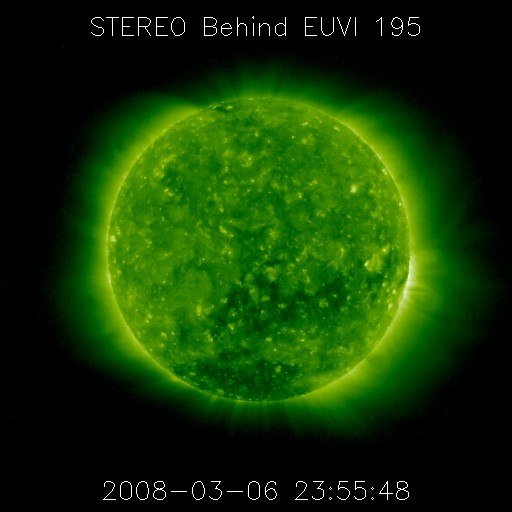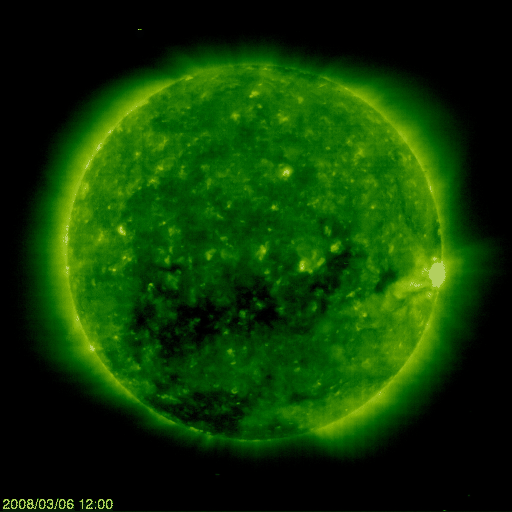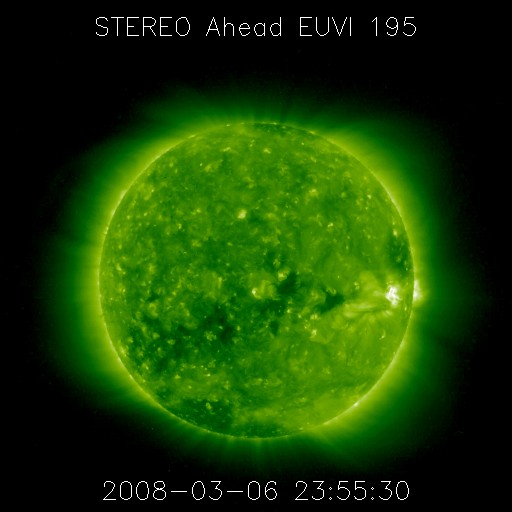


Version: 2008 Apr 3 (Added CDS)
This is a target of opportunity (TOO) within the Whole Heliosphere Interval (WHI).
The observation period is 20 Mar - 16 Apr 2008 (Carrington Rot. 2068).
Mar 29 - Mar 30 2008 as WHI TOO #2 (requested, approved)
Apr 03 - Apr 09 2008 as the main program for WHI Campaign #3
Apr 10 - Apr 11 2008 as WHI TOO #2 (requested, still pending)
| Hinode/EIS: | E. Landi (enrico.landi @ nrl.navy.mil) |
| Hinode/XRT: | Taro Sakao, J. Cirtain (Sakao.Taro @ isas.jaxa.jp, Jonathan.W.Cirtain @ nasa.gov) |
| Hinode/SOT: | Alphonse Sterling (alphonse.sterling @ nasa.gov) |
| SOHO/LASCO: | Guillermo Stenborg (stenborg @ grace.nascom.nasa.gov) |
| SOHO/SUMER: | E. Landi (enrico.landi @ nrl.navy.mil) |
| SOHO/UVCS: | M. P. Miralles (mmiralles @ cfa.harvard.edu) |
| SOHO/CELIAS: | Toni Galvin (toni.galvin @ unh.edu) |
| SOHO/EPHIN: | Robert F. Wimmer-Schweingruber (wimmer @ physik.uni-kiel.de) |
| SOHO/CDS: | Terry Kucera, John Rainnie (Therese.A.Kucera @ nasa.gov, J.A.Rainnie @ rl.ac.uk) |
| STEREO/SECCHI: | Simon Plunkett (simon.plunkett @ nrl.navy.mil) |
| STEREO/SEPT: | Robert F. Wimmer-Schweingruber (wimmer @ physik.uni-kiel.de) |
| STEREO/PLASTIC: | Toni Galvin, Kristin Simunac (toni.galvin @ unh.edu, ksimunac @ cisunix.unh.edu) |
| TRACE: | Kathy Reeves (kreeves @ cfa.harvard.edu) |
| Ooty Radio Telescope: | P. K. Manoharan (mano @ ncra.tifr.res.in) |
| STELAB IPS system: | Munetoshi Tokumaru (tokumaru @ stelab.nagoya-u.ac.jp) |
| Nancay Radioheliograph: | Alain Kerdraon (alain.kerdraon @ obspm.fr) |
| ACE/SWICS: | Robert F. Wimmer-Schweingruber (wimmer @ physik.uni-kiel.de) |
| Ulysses/SWICS: | Robert F. Wimmer-Schweingruber (wimmer @ physik.uni-kiel.de) |
| Ulysses/KET: | Robert F. Wimmer-Schweingruber (wimmer @ physik.uni-kiel.de) |
| MLSO/MK4: | Not Neccessary |
| NSO/SOLIS: | Carl Henney, Aimee Norton (chenney @ noao.edu, anorton @ noao.edu) |
| NSO-DST/IBIS: | Gianna Cauzzi, Kevin Reardon (gcauzzi @ arcetri.astro.it, kreardon @ arcetri.astro.it) |
To understand the origin of the solar wind from low-latitude coronal holes, including coronal hole boundaries by characterizing the physical properties of the coronal plasma (temperature, density, abundance, outflow velocity) with coordinated multi-spacecraft and ground-based observations in order to investigate the physical processes that lead to the origin of the solar wind.
These observations would improve on previous studies by coordinating observations with a battery of instruments providing co-spatial, co-temporal and good coverage in heliocentric distance from the solar disk to solar wind locations over 1 AU.
This study will combine spectroscopy, imaging, IPS and in-situ data to derive the plasma physical properties and the geometry of the coronal hole. The combination of these measurements would provide a 3-D view of solar wind properties.
We are interested in observing holes producing fast or slow wind. Fast solar wind speeds above 600 km/s have been reported for large equatorial coronal holes (Nolte et al. 1976, Miralles et al. 2001a). Slower solar wind speeds were reported for low-latitude holes of smaller size, between 300 and 600 km/s, near solar minimum (Neugebauer et al. 1998).
We are also interested in studying the temporal evolution of coronal and solar wind properties by monitoring plasma properties at different heights in the corona and in the solar wind during the campaign.
Jets and plumes have been studied on polar holes, but there are not many studies of those in low-latitude holes. The contribution and role of both, plumes and jets, to the solar wind is still unknown. This campaign will also emphasize on identifying and tracing jets and plumes from the solar surface into the accelerating solar wind and determining their physical properties as a function of height and time.
Target could be at any latitude, preference would be given to holes that are co-temporal with campaign and cleaner line-of-sights. Although coronal holes at lowest latitudes are also desirable for correspondence with some in situ measurements.
Target Observations:
Observations will take place, at least, in three positions: on-disk, disk-center, and at the limb (or on-disk and both limbs). These will be determined once we know the time allocated for this target of opportunity. Duration of the observations will depend on size of hole. Typical observing lengths of 3-5 days are usually required to include the characterization of regions in the foreground and background of the coronal hole line-of-sight.
Some instruments, like SOHO/UVCS, are designed to make observations at the limb, other instruments are capable of both, limb and disk observations. Note that the dates of the observation for the target will vary for some instruments.
Target candidates will be proposed by M. P. Miralles. An update on the list of candidates will take place one solar rotation prior to campaign Carrington Rotation (see below). Another update will take place 1/2 rotation before observations and will be communicated to the other instruments/campaign coordinators involved.
SOHO/UVCS will participate in WHI from 20 Mar - 16 Apr 2008 (Carrington Rot. 2068). We will run a joint observations coincidental with this time period.
Hinode plans were updated to reflect the current limited daily data volume.
Hinode/EIS will use two different sequences, depending on whether it will observe disk or off-disk targets. Disk coronal holes will be observed with a 1'x2' raster with a large number of diagnostic lines. Deep exposures of the entire EIS wavelength range are planned for off-disk target, with the full 512" slit that will allow us to study the CH/QS boundary in great detail.
The SOHO/SUMER sequence will focus on cool lines.
The SOHO/UVCS sequence will last longer and it will take place at the limb. The center of the UVCS slit will be at the P.A. of the equatorial hole center on the limb. SOHO/UVCS will observe a set of temperature and outflow diagnostic lines (including O VI and H I Lyman alpha) with a range of exposure times at higher heights.
Hinode/XRT primary observational interest is to obtain information on jets and bulk plasma properties in low-latitude coronal holes. XRT plan is to take images in the Al/poly (Q=95 compression, 384"x384" FOV, 1x1 binning, 8 sec exposures) and Be-thin (Q=95 compression, 384"x384" FOV, 1x1 binning, 23 sec exposures) filters. One image in each filter per minute. Run this sequence for 10 min, and then pause for ~50 min. Repeate as permitted by data volume.
TRACE will observe 512"x512" FOV in 171 A, with approximately a 60 sec cadence. We'll do full resolution, which is 0.5" pixels. The only time restriction is that from 10 Apr 2008 onward there are eclipses in all orbits, from 10 to 30 min. duration.
Hinode/SOT will observe standard FG CaII, photospheric, and magnetic line images, all at moderate cadence (2-3 min). This will be run in bursts of 10 min, followed by no-observation periods lasting ~50 min, to be repeated throughout the four-hour observation window. This will provide for evolution studies at two cadences: very rapid but extending for only 10 min, and hourly for the four-hour period of the run.
SOHO/LASCO will observe 4 to 6 LASCO C2 pB per day. These observations will allow us to estimate coronal densities at the positions where SOHO/UVCS acquires data.
SOHO/CDS will run the studies STRE4W (ID 11, studyvar. 111). Two or three rasters will be used to cover the area and boundaries of the coronal hole. Duration: several hours per day.
STEREO/SECCHI/EUVI and/or COR1: STEREO SECCHI normal synoptic data are sufficient.
In situ:
STEREO PLASTIC will provide solar wind proton and ion data. The cadence of the data is about 1 min for protons to about 1 hour for specific heavy ions.
ACE/SWICS, STEREO/SEPT, SOHO/EPHIN, Ulysses/SWICS, Ulysses/KET will participate in this campaign. The instruments are available at all times.
Radio scintillation data:
Ooty Radio Telescope operating at 327 MHz: will make solar wind estimates (using the Interplanetary Scintillation (IPS) technique) for the whole campaign period. These IPS measurements can provide a 3-D view of solar wind speed and density turbulence.
STELab 327MHz multi-station IPS system: will start observing on April 1st 2008, some delay may be expected bringing up the system after the winter. On or after April 1, data will be acquired daily from 22h and 7h UT. The distribution of the solar wind speed for radial distance between 0.1 and 1 AU will be derived over a Carrington rotation from a tomography analysis of IPS data. The solar wind speed map provided by STELab covers the entire range of heliographic longitude and latitude, and the speed estimate is given with a 1 deg by 1 deg pixel resolution, while a point spread function of the IPS observations is broader than one pixel.
Nancay daily observations from ~8:30 UT to 15:30 UT, 5 frequencies between 150 and 450 MHz, spatial resolution about 1 arcmin (depending on frequency) time cadence: several images per sec and per frequency FOV: full sun, images are normally computed with a 4 Rs FOV.
Ground based instrumentation:
NSO Detailed Observing Sequences:
DST/IBIS will capture chromospheric/photospheric dynamics at three altitudes in the lower atmosphere of the coronal hole. Line scan images in Fe I, Na D, and Ca II 854.2 nm (about 200, 500, 1000 km above the surface), with a 20-30 second cadence. The IBIS field of view will be 80 arcsec diameter. Daily Observations from 14:30 to 18:00 UT.
SOLIS observing window between 16 and 22 UT, with a modified core observing sequence: 1 full-disk photospheric 630 nm LOS magnetogram, 2 full-disk chromospheric 1083.0 nm spectroheliogram, 1 full-disk chromospheric 854.2 nm LOS magnetogram. This sequence will be repeated 3 times a day during the observing window (for the April 3 - 9 period). In addition, 1 full-disk vector magnetogram will be scheduled daily around local noon (19 UT).
MLSO Observing Plan: We plan to use normal cadence Mk4 images.
From the two low-latitude coronal holes present during February and March, we have selected the optimal target (see SOHO/EIT and STEREO EUVI 195 images below) that will be available for observation during the WHI campaign dates. The low-latitude coronal hole (seen as dark area) is shown close to the meridian in the images. Information about this target will be updated periodically.
The target has a good size and it is elongated: It is about 77 degrees in longitude and about >20 degrees or more in latitude. The latitude of the center of the hole is around -25 degrees (25 degrees South of the equator).



The time predictions for this hole during the campaign are respectively:
around March 25-31 (E limb), March 29-April 11 (disk),
April 07-13 (W limb).
First hole-boundary at meridian on April 1 2008